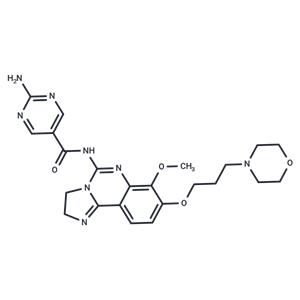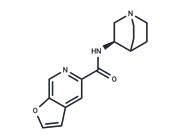| Name | Copanlisib |
| Description | Copanlisib (BAY 80-6946) is a phosphoinositide 3-kinase (PI3K) inhibitor with potential antineoplastic activity. By inhibiting the PI3K signaling pathway, Copanlisib may impede tumor cell growth and survival in certain tumor populations. Dysregulated PI3K signaling, often linked to tumorigenesis, may also contribute to tumor resistance to various antineoplastic agents. |
| Cell Research | Cell proliferation over a 72-hour period is determined using the CellTiter-Glo? luminescent cell viability kit. Briefly, cells are plated in separate microtiter plates. Following an overnight incubation at 37oC, luminescence values in the t=0 hour plates are determined. Test compounds diluted in growth medium are added to the t=72 hour plates, and the cells are then incubated for 72 hours at 37oC. Luminescence values are determined with a Wallac 1420 Victor2? 1420 multilabel HTS counter after a 10-minute reaction with CellTiter-Glo? solution. The percentage inhibition of cell growth is calculated by subtracting the luminescence values in the t=0 hour plates from the corresponding values in the t=72 hour plates. Differences in values between drug-treated cells and controls are used to determine the percentage inhibition of cell growth.(Only for Reference) |
| Kinase Assay | Biochemical lipid kinase assays: The effect of BAY 80-6946 on PI3Kα, PI3Kβ, and PI3Kγ activity is measured by the inhibition of 33P incorporation into phosphatidylinositol (PI) in 384-well MaxiSorp? plates coated with 2 μg/well of PI and phosphatidylserine (PS) (1:1 molar ratio). In each PI3K isoform assay, 9 μL of reaction buffer (50 mM MOPSO, pH 7.0, 100 mM NaCl, 4 mM MgCl2, 0.1% BSA) containing 7.5 ng of His-tagged N-terminal truncated p110α or p110β protein, or 25 ng of purified human p110γ protein, is used. The reaction is started by adding 5 μL of a 40-μM ATP solution containing 20 μCi/mL [33>/sup>P]-ATP. After 2 hours incubation at room temperature, the reaction is terminated by addition of 5 μL of a 25-mM EDTA solution. The plates are washed and Ultima Gold? scintillation cocktail (25 μL) is then added. The radioactivity incorporated into the immobilized PI substrate is determined with a BetaPlate Liquid Scintillation Counter. |
| In vitro | In both KPL4 cells and LPA-stimulated PC3 cells, Copanlisib reduces pAKT levels. In a subset of human cancer cell lines with PIK3CA mutations and/or overexpression of HER2, Copanlisib shows antiproliferative activity and induces apoptosis. [1] The combination of HER2-targeted therapies and Copanlisib inhibits growth more effectively than either therapy used alone, and can restore sensitivity to trastuzumab and lapatinib in cells. [2] |
| In vivo | In rat KPL4 or HCT116 tumor xenograft model, Copanlisib (6 mg/kg, i.v.) induces 100% complete tumor regression. In nude mice with Lu7860 erlotinib-resistant, patient-derived NSCLC and MAXF1398 patient-derived luminal breast tumor models, Copanlisib (14 mg/kg, i.v.) also causes tumor growth inhibition. [1] |
| Storage | Powder: -20°C for 3 years | In solvent: -80°C for 1 year | Shipping with blue ice. |
| Solubility Information | DMSO : < 1 mg/mL (insoluble or slightly soluble)
H2O : Insoluble
0.01M HCl : 10 mg/mL (20.81 mM), Sonication is recommended.
|
| Keywords | PI3K | Apoptosis | antiproliferative | antitumor | Inhibitor | administration | phosphorylation | sub-nanomolar | AKT | Phosphoinositide 3-kinase | inhibit | Copanlisib | intravenous |
| Inhibitors Related | Stavudine | Sodium 4-phenylbutyrate | Tributyrin |
| Related Compound Libraries | Bioactive Compound Library | Anti-Cancer Clinical Compound Library | Drug Repurposing Compound Library | Inhibitor Library | FDA-Approved Drug Library | Anti-Cancer Approved Drug Library | Anti-Cancer Active Compound Library |

 United States
United States



